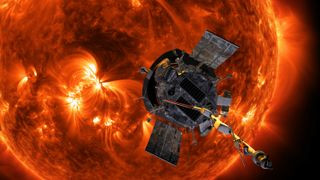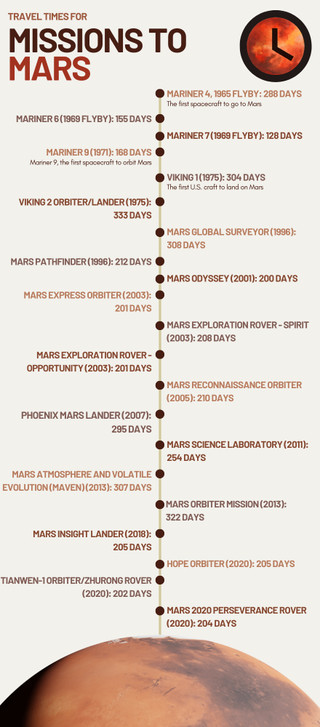Have you ever gazed at the red dot in the night sky and wondered about venturing to Mars? The journey to the Red Planet is a captivating prospect, but just how long does it take to fly to Mars?
While a one-way trip to Mars is often estimated at around nine months, and a return journey could stretch to approximately three years, the reality is more nuanced. These figures are just ballpark numbers. The actual duration of a flight to Mars is a complex equation influenced by a multitude of factors. The ever-changing distance between Earth and Mars, dictated by their orbital paths, and the sophistication of the spacecraft propulsion systems are key determinants in how long it takes to reach our celestial neighbor.
In this article, we’ll unpack the mechanics of Mars travel using current space technology. We will explore the various elements that impact the duration of this interplanetary voyage, providing a comprehensive understanding of what it takes to fly to Mars.
Understanding the Distance to Mars
Before we can calculate flight time, we need to understand the distance involved. How far away is Mars really?
Mars is the fourth planet from the Sun and Earth’s next-door neighbor in the solar system, with Venus being even closer. However, the distance between Earth and Mars is far from constant. As both planets journey around the sun in their respective orbits, the gap between them fluctuates dramatically.
 Graphic illustration of an astronaut walking on the surface of Mars.
Graphic illustration of an astronaut walking on the surface of Mars.
In an ideal scenario, the closest Earth and Mars could ever get is when Mars is at its perihelion (closest point to the sun) and Earth is at its aphelion (farthest point from the sun). This theoretical minimum distance is about 33.9 million miles (54.6 million kilometers). However, this perfect alignment has never been recorded. The closest approach in recorded history occurred in 2003, with a distance of 34.8 million miles (56 million km).
Conversely, Earth and Mars are at their furthest when they are both at aphelion, positioned on opposite sides of the sun. At this maximum separation, they can be as far apart as 250 million miles (401 million km).
The average distance that usually gets cited for Earth and Mars is approximately 140 million miles (225 million km).
Related Article: What is the temperature on Mars?
Mars Travel Time at the Speed of Light
To put these distances into perspective, let’s consider the speed of light, the ultimate speed limit in the universe. Light travels at a staggering speed of roughly 186,282 miles per second (299,792 km per second). If we could send a light beam from Mars to Earth (or vice versa), how long would it take?
- Closest Possible Approach: Light would take about 182 seconds, or just over 3 minutes (3.03 minutes).
- Closest Recorded Approach (2003): Around 187 seconds, or approximately 3.11 minutes.
- Farthest Approach: A much longer 1,342 seconds, which is about 22.4 minutes.
- Average Distance: On average, light would take 751 seconds, or roughly 12.5 minutes to travel between Earth and Mars.
 Image of Mars against the black backdrop of space. The planet is a rusty red color.
Image of Mars against the black backdrop of space. The planet is a rusty red color.
These light-speed calculations highlight the immense distances involved in interplanetary travel, even to our closest planetary neighbor.
Travel Time with the Fastest Spacecraft
While light speed is unattainable for spacecraft, let’s consider the fastest spacecraft ever built: NASA’s Parker Solar Probe. This probe, designed to study the sun, has broken its own speed records multiple times. On December 24, 2024, it reached a peak velocity of 430,000 miles per hour (692,000 km per hour).
Imagine if we could redirect the Parker Solar Probe from its solar mission and send it on a direct trajectory to Mars, traveling at its peak speed. How long would that theoretical journey take?
- Closest Possible Approach: Approximately 78.84 hours, or about 3.3 days.
- Closest Recorded Approach: Around 80.93 hours, or roughly 3.4 days.
- Farthest Approach: A much longer 581.4 hours, translating to about 24.2 days.
- Average Distance: Approximately 325.58 hours, or about 13.6 days.
 Graphic illustration shows the Parker Solar Probe in front of the blazing sun.
Graphic illustration shows the Parker Solar Probe in front of the blazing sun.
While these theoretical calculations are impressive, achieving these travel times to Mars in reality is far more complex.
Expert Insights on Mars Travel Time
To delve deeper into the complexities of Mars travel time, we consulted Michael Khan, a Senior Mission Analyst at the European Space Agency (ESA). His expertise lies in the orbital mechanics of interplanetary journeys, including missions to Mars.
Michael Khan
Senior Mission Analyst, European Space Agency (ESA)
Factors Affecting Mars Travel Time
Q: How long does it actually take to get to Mars, and what are the primary factors influencing the travel time?
Michael Khan: The duration of a journey between celestial bodies, like Earth and Mars, is fundamentally determined by the amount of energy you are willing to expend. In space travel, “energy” encompasses the power of the launch vehicle, the maneuvers executed by the spacecraft’s onboard rocket motors, and the amount of propellant consumed. Efficient spaceflight is essentially about the clever management of energy.
For lunar missions, common transfer solutions include the Hohmann transfer and the Free Return Trajectory. The Hohmann transfer is often cited as the most energy-efficient, particularly for short-duration transfers lasting just a few days, and under certain launch constraints. However, the intricacies of orbital mechanics quickly become complex.
Interplanetary transfers to Mars, orbits around the sun, are inherently more complex. The principle of energy expenditure remains paramount. Adding to the complexity is Mars’s elliptical orbit, its orbital plane’s inclination relative to Earth’s, and its longer orbital period around the sun.
Trajectory experts use “pork chop plots” to visualize these complexities. These plots illustrate the optimal departure and arrival dates and the energy required for Mars transfers. They reveal that launch opportunities for Mars missions arise roughly every 25 to 26 months. These transfer windows are further categorized into faster trajectories, taking about 5-8 months, and slower, more energy-efficient trajectories, ranging from 7-11 months. While longer transfer options exist, they are less commonly considered for typical missions.
A common rule of thumb is that a Mars transfer takes approximately the same duration as human gestation, around 9 months. However, this is merely an approximation. Precise calculations are always necessary to determine the optimal trajectory for specific launch dates.
Why Orbiting or Landing Missions Take Longer
Q: Why do spacecraft missions designed to orbit or land on Mars typically have longer journey times compared to flyby missions?
Michael Khan: When a mission requires a spacecraft to enter Mars orbit or land on the surface, significant constraints are added to the mission design. Orbiters need substantial propellant for orbit insertion maneuvers, while landers require robust heat shields to withstand atmospheric entry. These requirements impose limitations on the spacecraft’s arrival velocity at Mars.
To manage these constraints, trajectory optimization often favors Hohmann-like transfers, which, while energy-efficient for reaching Mars orbit or landing, typically result in longer overall transfer durations.
Challenges in Calculating Mars Travel Time
The straight-line distance calculations we discussed earlier provide a simplified view. In reality, spacecraft don’t travel in straight lines between planets. A direct path between Earth and Mars at their farthest point would theoretically pass directly through the sun – an impossible trajectory. Spacecraft must follow orbital paths within the solar system.
Even when planets are closer, assuming a constant distance throughout the journey is inaccurate. Both Earth and Mars are constantly moving at different speeds in their orbits around the sun. Mission engineers must account for this planetary motion. It’s akin to aiming a dart at a moving target from a moving vehicle. They need to calculate where Mars will be when the spacecraft arrives, not where it is at launch.
Furthermore, maximizing speed isn’t always the goal, especially for missions intended to orbit or land. Spacecraft must arrive at Mars at a controlled speed to execute orbit insertion maneuvers successfully. Simply zipping past Mars at high speed defeats the purpose of orbital or landing missions.
Technological advancements in propulsion systems also play a crucial role in determining Mars travel time.
According to NASA Goddard Space Flight Center, an ideal launch window for Mars missions results in a roughly nine-month journey. Physics professor Craig C. Patten from the University of California, San Diego, explains this in more detail:
“It takes the Earth one year to orbit the sun, and Mars takes about 1.9 years (approximately 2 years for simplification). The elliptical transfer orbit from Earth to Mars is longer than Earth’s orbit but shorter than Mars’s. Averaging these orbital periods, we can estimate the transfer orbit duration to be about one and a half years.
“However, in the nine months it takes to reach Mars’s orbital distance, Mars itself moves a significant portion of its orbit, about three-eighths of the way around the sun. Therefore, launch timing is critical. We must ensure that when the spacecraft reaches Mars’s orbital distance, Mars is precisely at the rendezvous point. This alignment opportunity occurs only every 26 months, defining the launch windows.”
While shorter travel times are theoretically achievable by burning more fuel, this is currently not optimal with existing propulsion technology.
Future Technologies and Faster Mars Travel
Evolving technologies hold the promise of significantly reducing Mars flight times. NASA’s Space Launch System (SLS), designed as a powerful next-generation launch vehicle, is intended to carry future missions, potentially including human missions, to Mars.
Looking further ahead, more radical propulsion concepts could revolutionize interplanetary travel. Photon propulsion, for example, proposes using powerful lasers to propel spacecraft to velocities approaching the speed of light. Philip Lubin, a physics professor at the University of California, Santa Barbara, is leading research into Directed Energy Propulsion for Interstellar Exploration (DEEP-IN). He suggests that this method could potentially send a 220-lb. (100 kilograms) robotic spacecraft to Mars in a mere three days.
“Recent advancements are moving this concept from science fiction towards science reality,” Lubin stated at the 2015 NASA Innovative Advanced Concepts (NIAC) fall symposium. “There is no fundamental reason why this cannot be achieved.”
Historical Mars Mission Travel Times
To provide a historical perspective, here’s an overview of the travel times for several past Mars missions, including their launch dates:
 Timeline of missions to Mars.
Timeline of missions to Mars.
This timeline illustrates the typical flight durations for past Mars missions, highlighting the variations depending on launch windows and mission objectives.
Further Resources
To explore more about Mars exploration and related topics, refer to these resources:
- NASA Moon to Mars Overview: Moon to Mars overview
- The Conversation: How to get people from Earth to Mars and safely back again: The Conversation Article
- Nature Research Paper: Human health risks of a mission to the Red Planet: Nature Research Paper
Bibliography
Join our Space Forums to continue the space conversation regarding latest missions, night sky events and more. For news tips, corrections or comments, contact us at: [email protected].
Stay Updated with Space.com
For the latest space news, rocket launch updates, skywatching events, and more, subscribe to the Space.com Newsletter!
Daisy Dobrijevic, Reference Editor
With contributions from Space.com Staff
